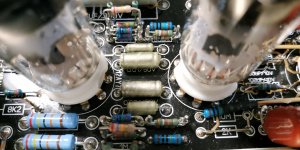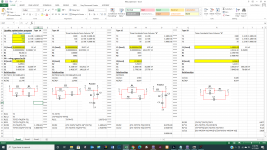Hi, there is an "automatic" calculator on the internet to calculate the value of components for the RIAA in a prephono scheme like the ear834 (the RIAA ring includes the tube v2 and v3) and like the Marantz 7 or Audioresearch sp3/6/8 (RIAA ring includes all 3 tubes)? Many thanks 
Thanks for the file, nice! I downloaded the program, it is very complex, but, starting from the file, I can start simulating.
I ask one a direct question, if possible...
I have an EAR834 clone, in which, due to heavy load reasons, I have implemented a 6n6p as follower cathode. Excellent results.
I wanted to implement the AR sp3/6/8 riaa configuration, in order to be able to operate more freely on the working points of the V1 and V2 stages and because I think it is "better" for other aspects.
The AR riaa configuration is with new AR component values and connected to the cathode of v1.
Everything works fine.
The only problem is that now I have the same gain as AR, which is about 35/36db against almost 50db of EAR.
For my audio setup, 35db of gain is low.
And now the milion dollar question:
Can this AR riaa configuration allow you to have a gain greater than 35db?
In my setup I would like 45/48db.
Or, to have this gain, am I forced to go back to the EAR riaa, connected again to the v2 grid?
I hope I haven't disturbed with this post.
 Thanks
Thanks 
I ask one a direct question, if possible...
I have an EAR834 clone, in which, due to heavy load reasons, I have implemented a 6n6p as follower cathode. Excellent results.
I wanted to implement the AR sp3/6/8 riaa configuration, in order to be able to operate more freely on the working points of the V1 and V2 stages and because I think it is "better" for other aspects.
The AR riaa configuration is with new AR component values and connected to the cathode of v1.
Everything works fine.
The only problem is that now I have the same gain as AR, which is about 35/36db against almost 50db of EAR.
For my audio setup, 35db of gain is low.
And now the milion dollar question:
Can this AR riaa configuration allow you to have a gain greater than 35db?
In my setup I would like 45/48db.
Or, to have this gain, am I forced to go back to the EAR riaa, connected again to the v2 grid?
I hope I haven't disturbed with this post.
"Can this AR riaa configuration allow you to have a gain greater than 35db?"
No. You start with the desired gain, and then design the circuit.
The original EAR (without the cascoded fet input) can only have higher midband gain
mainly because the bass runs open loop with no feedback, like the Quad preamp.
In other words, they cheat.
No. You start with the desired gain, and then design the circuit.
The original EAR (without the cascoded fet input) can only have higher midband gain
mainly because the bass runs open loop with no feedback, like the Quad preamp.
In other words, they cheat.
Last edited:
Thank you again.
The problem is that on a pcb they are complicated implementations.
I struggled a lot to adopt the fully functional AR riaa.
I struggled hard with layout-related swings (noises, whistles, triggers, high frequency oscillations).
A simple question:
how many components must compose a passive ria between v1 and v2. I ask to think about the space available.
AR riaa is with 2 cap + 2 resistor (except it needs parallels)

The problem is that on a pcb they are complicated implementations.
I struggled a lot to adopt the fully functional AR riaa.
I struggled hard with layout-related swings (noises, whistles, triggers, high frequency oscillations).
A simple question:
how many components must compose a passive ria between v1 and v2. I ask to think about the space available.
AR riaa is with 2 cap + 2 resistor (except it needs parallels)
The simple answer is: a lot: I use series/parallel components to trim for the highest accuracy. But then again, the solution is simple: think 3D: I solder some pins and build UP. Still, you need to think, plan and execute with a lot of care.
An externally hosted image should be here but it was not working when we last tested it.
Bear in mind that the source resistance of the first stage must be taken into account with
the R1 value. Also the capacitive input impedance for the second stage with the C2 value.
HiFi Loudspeaker Design
https://www.kabusa.com/riaa.htm
the R1 value. Also the capacitive input impedance for the second stage with the C2 value.
HiFi Loudspeaker Design
https://www.kabusa.com/riaa.htm
Last edited:
I have an excel spreadsheet which allows you to calculate the values for the 4 Lipshitz transforms -- enter the time constants and "seed" values of R1 or C1 and it spits out the rest. I tried to upload it, but get an error message.
Put the excel in a zip file, then it is possible to upload it.
Hi jackinnj, thanks.
But this is for calculate active riaa or passive?
Thanks
Both
That was a bit inconsiderate response by me -- 1b and 1c can be used for active and passive. The resistive elements become the feedback resistor in the network active RIAA comp network. This being said, you need to know the impedance to get all the bits right.
If you are going to use 1b or 1c in a passive "sand-state" network the anode impedance becomes part of "R1"
Lipshitz paper deals with this, quite difficult to dilate without the paper.
If you are going to use 1b or 1c in a passive "sand-state" network the anode impedance becomes part of "R1"
Lipshitz paper deals with this, quite difficult to dilate without the paper.
- Home
- Source & Line
- Analogue Source
- Active RIAA component calculator for tube prephono

